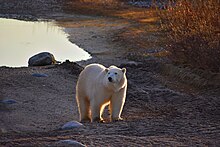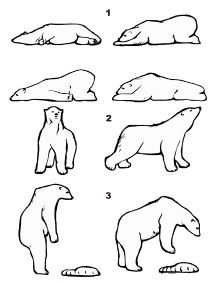User:Emkmiller100/Effects of climate change on marine mammals
Species impacted[edit]
Polar Bears


Polar bears are one of many Arctic marine mammals at risk of population decline due to climate change[1]. When carbon dioxide is released into the atmosphere, a greenhouse like effect occurs, warming the climate. For polar bears and other Arctic marine mammals, rising temperature is the changing the sea ice formations that they rely on to survive[2]. In the circumpolar north, the Arctic sea ice is a dynamic ecosystem. The levels of sea ice extent varies by season. While some areas maintain year-round ice, others only have ice on a seasonal basis. The amount of permanent sea ice is decreasing with global temperature increases. Climate change is causing slower formations of sea ice, quicker decline and thinner ice sheets. Polar bears and other Arctic marine mammals are losing their habitat and food sources in result of the sea ice decline[3].
Polar bears rely on seals as their main food source[4]. Although polar bears are strong swimmers, they are not successful at catching seal underwater, therefore polar bears are ambush predators[5]. When they hunt seals, they wait at seal breathing hole to ambush and haul out their prey onto the sea ice for feeding. With slower sea ice formations, thinner ice sheets and shorter winter seasons, polar bears are having less opportunity for optimal hunting grounds. Polar bears are facing pressures to swim further to gain access to food. This requires more calories spent to obtain calories to sustain their body conditions for reproduction and survival. Researchers use body condition charts to track polar bear population health and reproductive potential.[6] Trends suggest 12 out of 19 sub populations of polar bears are declining or data deficient.[7]
Polar bears also rely on sea ice to travel, mate and female polar bears usually choose to den up on the sea ice during denning season[8]. The sea ice is becoming less stable, forcing pregnant female polar bears to choose less optimal locations for denning[9]. These aspects are known to result in lower reproduction rates and smaller cub years.
Other Species
Not only are marine mammals impacted by climate change but so is other marine life. An example of this could be coral. When coral is introduced to warming ocean temperatures changes, runoff and pollution, overexposure to sunlight extremely low tides and other stresses, the coral will expel an algae growing on them. They have a symbiotic relationship with the algae. When the coral expels the algae it becomes bleached or "completely white". This is called coral bleaching. The coral then become more vulnerable to disease and death.
- ^ Stirling, Ian; Lunn, Nicholas J.; Iacozza, John (1999-01-01). "Long-term Trends in the Population Ecology of Polar Bears in Western Hudson Bay in Relation to Climatic Change". ARCTIC. 52 (3). doi:10.14430/arctic935. ISSN 1923-1245.
- ^ Stirling, Ian; Lunn, Nicholas J.; Iacozza, John (1999-01-01). "Long-term Trends in the Population Ecology of Polar Bears in Western Hudson Bay in Relation to Climatic Change". ARCTIC. 52 (3). doi:10.14430/arctic935. ISSN 1923-1245.
- ^ T., DeWeaver, Eric (2013). Arctic Sea Ice Decline : Observations, Projections, Mechanisms, and Implications. Wiley. ISBN 978-1-118-67158-0. OCLC 850080201.
{{cite book}}: CS1 maint: multiple names: authors list (link) - ^ Malcolm., Penny, (2000). Polar bear : habitats, life cycles, food chains, threats. Raintree Steck-Vaughn Publishers. ISBN 0-7398-1060-X. OCLC 41565047.
{{cite book}}: CS1 maint: extra punctuation (link) CS1 maint: multiple names: authors list (link) - ^ D.), Tarbox, A. D. (Angelique (2009). An Arctic tundra food chain. Creative Education. ISBN 978-1-58341-596-2. OCLC 78072263.
{{cite book}}: CS1 maint: multiple names: authors list (link) - ^ Michael., Pagano, Anthony. Polar Bear (Ursus maritimus) Behavior and Energetics : New Metrics for Examining the Physiological Impact of a Changing Arctic Environment. ISBN 978-0-438-24947-9. OCLC 1076545435.
{{cite book}}: CS1 maint: multiple names: authors list (link) - ^ V., Regehr, Eric (2006). Polar bear population status in the southern Beaufort Sea. U.S. Geological Survey. OCLC 76881605.
{{cite book}}: CS1 maint: multiple names: authors list (link) - ^ Riddihough, G. (2010-03-18). "Polar Bear, Polar Bear". Science. 327 (5972): 1430–1431. doi:10.1126/science.327.5972.1430-d. ISSN 0036-8075.
- ^ T., DeWeaver, Eric (2013). Arctic Sea Ice Decline : Observations, Projections, Mechanisms, and Implications. Wiley. ISBN 978-1-118-67158-0. OCLC 850080201.
{{cite book}}: CS1 maint: multiple names: authors list (link)
